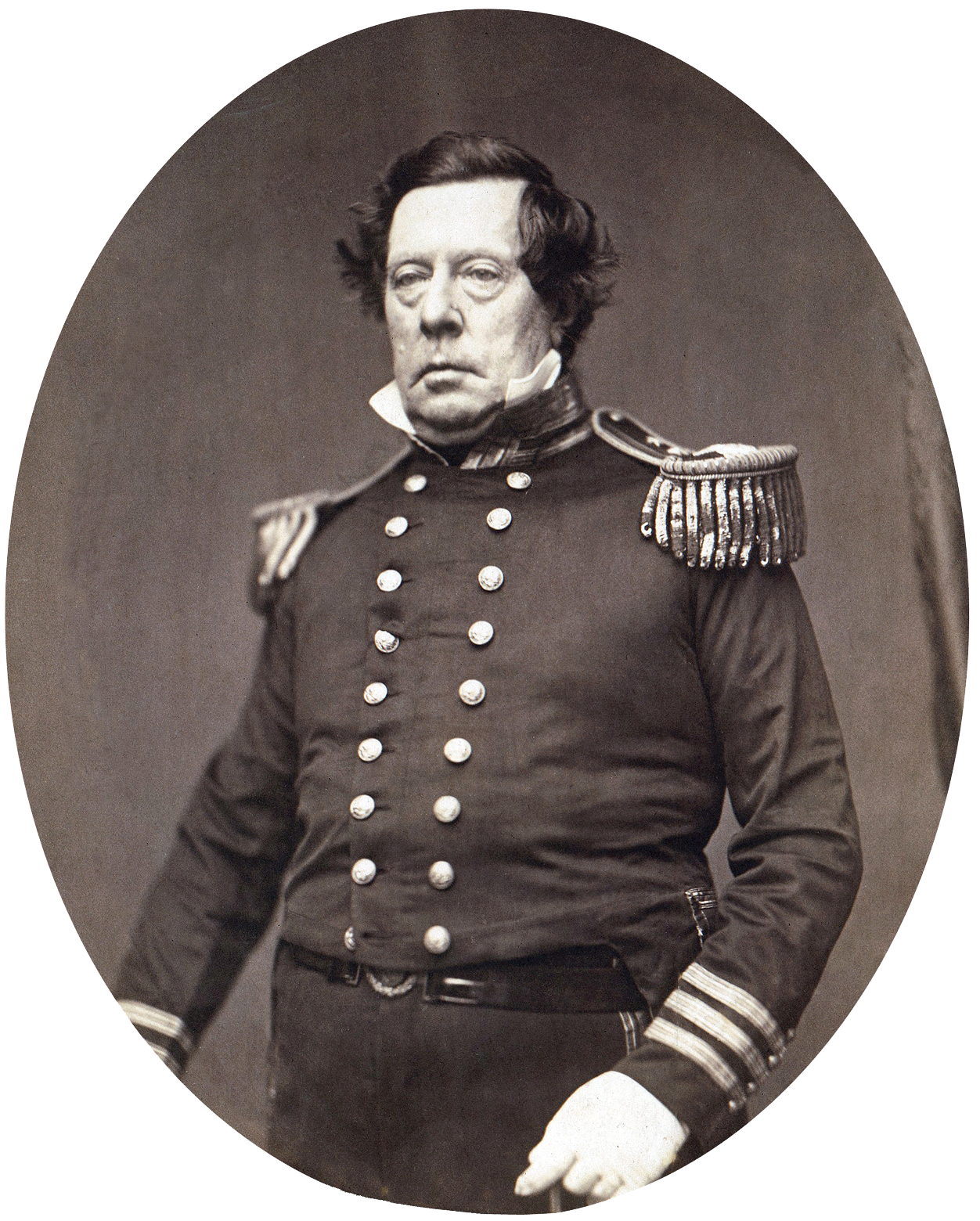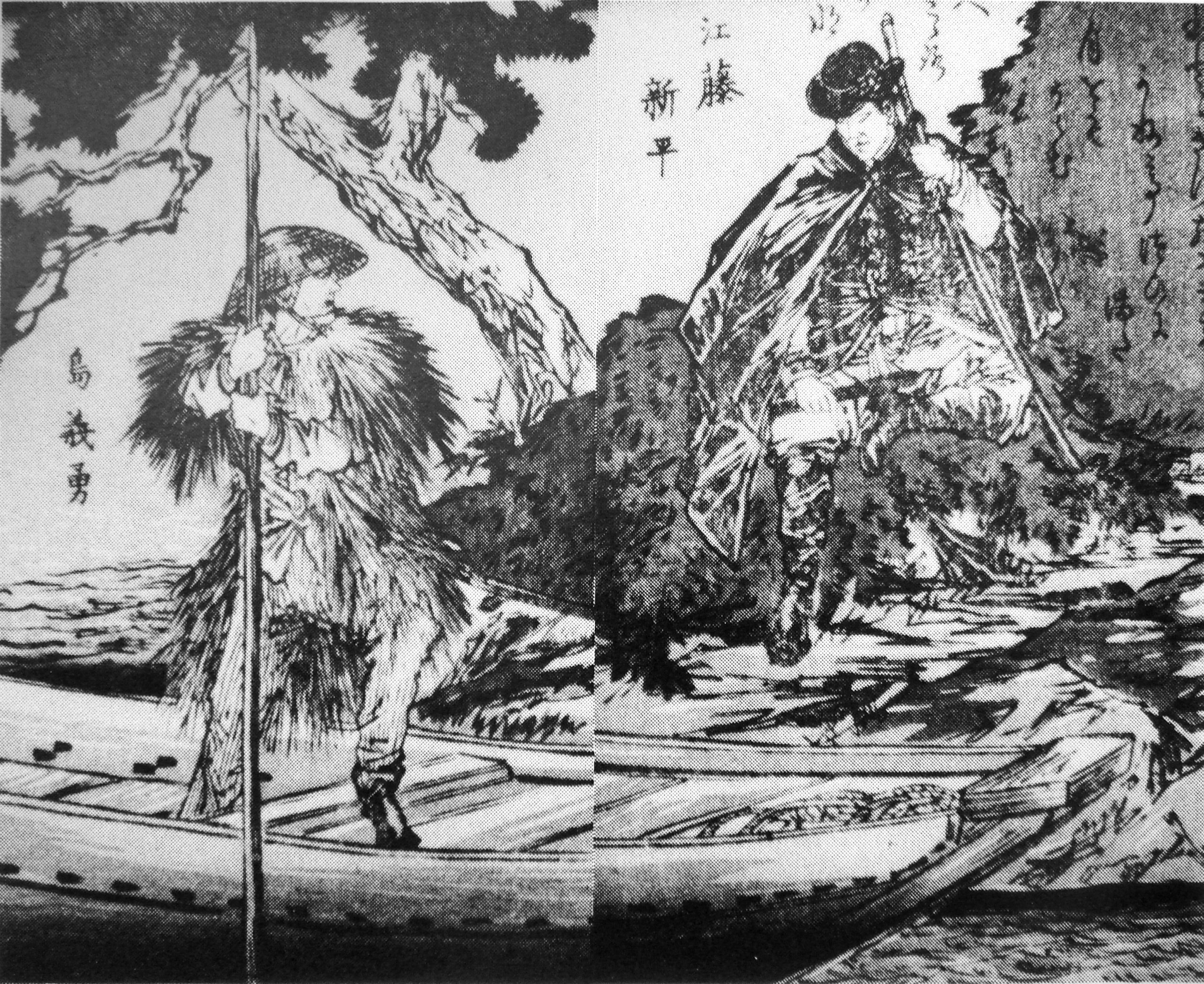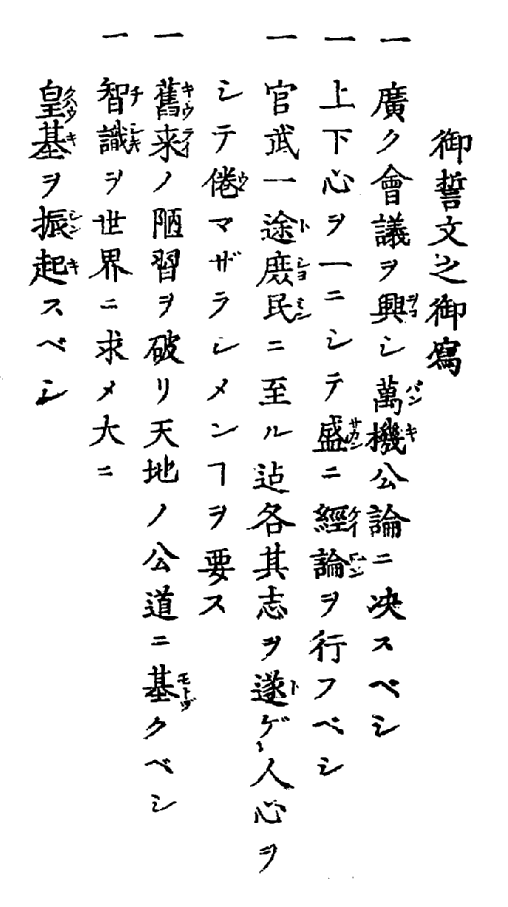|
Meiji Reformation
The , referred to at the time as the , and also known as the Meiji Renovation, Revolution, Regeneration, Reform, or Renewal, was a political event that restored imperial rule to Japan in 1868 under Emperor Meiji. Although there were ruling emperors before the Meiji Restoration, the events restored practical power to, and consolidated the political system under, the Emperor of Japan. The Restoration led to enormous changes in Japan's political and social structure and spanned both the late Edo period (often called the Bakumatsu) and the beginning of the Meiji era, during which time Japan rapidly industrialised and adopted Western ideas and production methods. The origins of the Restoration lay in economic and political difficulties faced by the Tokugawa shogunate. These problems were compounded by the encroachment of foreign powers in the region which challenged the Tokugawa policy of , specifically the arrival of the Perry Expedition under orders from United States president Mi ... [...More Info...] [...Related Items...] OR: [Wikipedia] [Google] [Baidu] |
Bakumatsu
were the final years of the Edo period when the Tokugawa shogunate Meiji Restoration, ended. Between 1853 and 1867, under foreign diplomatic and military pressure, Japan ended its isolationist foreign policy known as and changed from a Feudalism, feudal Tokugawa shogunate to the Empire of Japan, modern empire of the Meiji era, Meiji Government of Meiji Japan, government. The major ideological-political divide during this period was between the pro-imperial Nationalism, nationalists called and the shogunate forces, which included the elite swordsmen. Although these two groups were the most visible powers, many other factions attempted to use the chaos of to seize personal power. Furthermore, there were two other main driving forces for dissent: first, growing resentment on the part of the (or outside lords), and second, growing anti-Western sentiment following the arrival of Matthew C. Perry. The first related to those lords whose predecessors had fought against Tokugawa for ... [...More Info...] [...Related Items...] OR: [Wikipedia] [Google] [Baidu] |
Perry Expedition
] The Perry Expedition (, , "Arrival of the Black Ships") was a diplomatic and military expedition in two separate voyages (1852–1853 and 1854–1855) to the Tokugawa shogunate () by warships of the United States Navy. The goals of this expedition included exploration, surveying, and the establishment of diplomatic relations and negotiation of trade agreements with the various nations in the region. Opening contact with the government of Japan was considered a top priority of the expedition, and was one of the key reasons for its inception. The expedition was commanded by Commodore Matthew Calbraith Perry, under orders from President Millard Fillmore. Perry's primary goal was to force an end to Japan's 220-year-old policy of isolation and to open Japanese ports to American trade, through the use of gunboat diplomacy if necessary. The Perry Expedition led directly to the establishment of diplomatic relations between Japan and the western Great Powers, and eventually to ... [...More Info...] [...Related Items...] OR: [Wikipedia] [Google] [Baidu] |
East Asia
East Asia is a geocultural region of Asia. It includes China, Japan, Mongolia, North Korea, South Korea, and Taiwan, plus two special administrative regions of China, Hong Kong and Macau. The economies of Economy of China, China, Economy of Japan, Japan, Economy of South Korea, South Korea, and Economy of Taiwan, Taiwan are among the world's largest and most prosperous. East Asia borders North Asia to the north, Southeast Asia to the south, South Asia to the southwest, and Central Asia to the west. To its east is the Pacific Ocean. East Asia, especially History of China, Chinese civilization, is regarded as one of the earliest Cradle of civilization#China, cradles of civilization. Other ancient civilizations in East Asia that still exist as independent countries in the present day include the History of Japan, Japanese, History of Korea, Korean, and History of Mongolia, Mongolian civilizations. Various other civilizations existed as independent polities in East Asia in the past ... [...More Info...] [...Related Items...] OR: [Wikipedia] [Google] [Baidu] |
Satsuma Rebellion
The Satsuma Rebellion, also known as the , was a revolt of disaffected samurai against the new imperial government of the Empire of Japan, nine years into the Meiji era. Its name comes from the Satsuma Domain, which had been influential in the Meiji Restoration, Restoration and became home to unemployed samurai after military reforms rendered their status obsolete. The rebellion lasted from 29 January until 24 September of 1877, when it was decisively crushed, and its leader, Saigō Takamori, was shot and mortally wounded. Saigō's rebellion was the last and most serious of a series of armed uprisings against the new government of the Empire of Japan, the predecessor state to modern Japan. The rebellion was very expensive for the government, which forced it to make numerous monetary reforms including leaving the gold standard. The conflict effectively ended the samurai class and ushered in modern warfare fought by conscript soldiers instead of military nobles. It is also th ... [...More Info...] [...Related Items...] OR: [Wikipedia] [Google] [Baidu] |
Saga Rebellion
The was an 1874 uprising in Kyūshū against the new Meiji government of Japan.Nussbaum, Louis-Frédéric. (2005). "Saga no ran" in . It was led by Etō Shinpei and Shima Yoshitake in their native domain of Hizen province, Hizen. Background Following the 1868 Meiji Restoration, many members of the former ''samurai'' class were disgruntled with the direction the nation had taken. The abolition of their former privileged social status under the feudal order had also eliminated their income, and the establishment of universal military conscription had eliminated much of their reason for existence. The very rapid modernization (Westernization) of the country was resulting in massive changes to Japanese culture, List of gairaigo and wasei-eigo terms, language, dress and society, and appeared to many samurai to be a betrayal of the ''jōi'' (“Expel the Barbarian”) portion of the ''Sonnō jōi'' justification used to overthrow the former Tokugawa shogunate. Hizen Province, with a ... [...More Info...] [...Related Items...] OR: [Wikipedia] [Google] [Baidu] |
Westernization
Westernization (or Westernisation, see spelling differences), also Europeanisation or occidentalization (from the ''Occident''), is a process whereby societies come under or adopt what is considered to be Western culture, in areas such as industry, technology, science, education, politics, economics, lifestyle, law, norms, mores, customs, traditions, values, mentality, perceptions, diet, clothing, language, writing system, religion, and philosophy. During colonialism it often involved the spread of Christianity. A related concept is Northernization, which is the consolidation or influence of the Global North. Westernization has been a growing influence across the world in the last few centuries, with some thinkers assuming Westernization to be the equivalent of modernization, a way of thought that is often debated. The overall process of Westernization is often two-sided in that Western influences and interests themselves are joined with parts of the affected society, at mini ... [...More Info...] [...Related Items...] OR: [Wikipedia] [Google] [Baidu] |
Republic Of Ezo
The was a short-lived separatist state established in 1869 on the island of Ezo, now Hokkaido, by a part of the former military of the Tokugawa shogunate at the end of the ''Bakumatsu'' period in Japan. It was the first government to attempt to institute democracy in Japan, though voting was allowed only to the samurai caste. The Republic of Ezo existed for five months before being annexed by the newly established Empire of Japan. Background left, Troops of the former ''bakufu'' being transported to Ezo (Hokkaido) in 1868 After the overthrow of the Tokugawa shogunate (''bakufu'') in the Boshin War by the Meiji Restoration, a part of the former ''shōgun''s navy, led by Admiral Enomoto Takeaki, retreated from the capital Edo (Tokyo) in October 1868, sailing north to continue the fight against the advancing Imperial army. Along with Enomoto were many other former Tokugawa officers, including the Commander-in-Chief of the shogunate's army, Matsudaira Tarō, and French office ... [...More Info...] [...Related Items...] OR: [Wikipedia] [Google] [Baidu] |
Boshin War
The , sometimes known as the Japanese Revolution or Japanese Civil War, was a civil war in Japan fought from 1868 to 1869 between forces of the ruling Tokugawa shogunate and a coalition seeking to seize political power in the name of the Imperial Court in Kyoto, Imperial Court. The war stemmed from dissatisfaction among many Kazoku, nobles and young samurai with the shogunate's handling of foreigners following the opening of Japan during the prior decade. Increasing Unequal treaties, Western influence in the economy led to a decline similar to that of other Asian countries at the time. An alliance of western samurai, particularly the domains of Chōshū Domain, Chōshū, Satsuma Domain, Satsuma, and Tosa Domain, Tosa, and court officials secured control of the Imperial Court and influenced the young Emperor Meiji. Tokugawa Yoshinobu, the sitting ''shōgun'', realizing the futility of his situation, abdicated and handed over political power to the emperor. Yoshinobu had hoped t ... [...More Info...] [...Related Items...] OR: [Wikipedia] [Google] [Baidu] |
Charter Oath
The was promulgated on 6 April 1868 in Kyoto Imperial Palace. The Oath outlined the main aims and the course of action to be followed during Emperor Meiji's reign, setting the legal stage for Japan's modernization. This also set up a process of urbanization as people of all classes were free to move jobs so people went to the city for better work. It remained influential, though less for governing than inspiring, throughout the Meiji era and into the twentieth century, and it can be considered the first constitution of modern Japan. Rules As the name implies, the text of the Oath consists of five clauses: Origin and subsequent influence The first draft of the Oath was written by junior councilor Yuri Kimimasa in January 1868, containing progressive language that spoke to the frustrations that the radical but modestly born Meiji leaders had experienced in "service to hereditary incompetents".Jansen (2002), p. 338. Yuri's language was moderated by his colleague Fukuoka Takachi ... [...More Info...] [...Related Items...] OR: [Wikipedia] [Google] [Baidu] |
Satchō Alliance
The , or was a powerful military alliance between the southwestern feudal domains of Satsuma and Chōshū formed in 1866 to combine their efforts to restore Imperial rule and overthrow the Tokugawa shogunate of Japan. History The name ''Satchō'' () is an abbreviation combining the names of the provinces Satsuma (present day Kagoshima Prefecture) and Chōshū (present-day Yamaguchi Prefecture), two of the strongest Imperialist '' tozama'' domains in Edo-period Japan. In the 1860s, Satsuma tended to take a moderate position towards maintenance of the status quo, whereas Chōshū had become the center of an uprising aimed at overthrowing the government. Through the mediation of Sakamoto Ryōma of Tosa Domain (present day Kōchi Prefecture), Satsuma military leaders Saigō Takamori and Ōkubo Toshimichi were brought together with Katsura Kogorō of Chōshū Domain. Although the two domains were traditionally fierce enemies, their leaders agreed that the time was righ ... [...More Info...] [...Related Items...] OR: [Wikipedia] [Google] [Baidu] |
Order To Expel Barbarians
The was an edict issued by the Japanese Emperor Kōmei in 1863 against the Westernization of Japan following the opening of the country by Commodore Matthew Perry in 1854. The order The edict was based on widespread anti-foreign and legitimist sentiment, called the " Revere the Emperor, Expel the Barbarians" movement. Emperor Kōmei personally agreed with such sentiments, and – breaking with centuries of imperial tradition – began to take an active role in matters of state: as opportunities arose, he fulminated against the treaties and attempted to interfere in the shogunal succession. His efforts culminated on March 11, 1863 with his "Order to expel barbarians". A deadline for the expulsion was set two months later to May 11. Consequences The Tokugawa shogunate had no intention of enforcing the order, and the edict inspired attacks against the shogunate itself as well as against foreigners in Japan. The most famous incident was the firing on foreign shipping in the Shimon ... [...More Info...] [...Related Items...] OR: [Wikipedia] [Google] [Baidu] |
Shishi (Japan)
, sometimes known as , were a group of Japanese political activists of the late Edo period. While it is usually applied to the samurai primarily from the southwestern clans of Satsuma, Chōshū, and Tosa, the term ''shishi'' is also used by some with reference to supporters of the shogunate, such as the '' Shinsengumi''. There were many different varieties of ''shishi''. Some, such as the assassins Kawakami Gensai, Nakamura Hanjirō, Okada Izō, and Tanaka Shinbei, opted for a more violent approach in asserting their views. Kawakami Gensai, in particular, is recalled as the assassin of Sakuma Shōzan, a renowned pro-Western thinker of the time. Several assaults on westerners in Japan have been attributed to the ''shishi'' and associated ''rōnin'' warriors. In a 2013 article, these assassins have been called "early terrorists" () since they opted to spread terror among the foreigners. Other more radical ''shishi'', such as Miyabe Teizō, plotted large-scale attacks wit ... [...More Info...] [...Related Items...] OR: [Wikipedia] [Google] [Baidu] |









